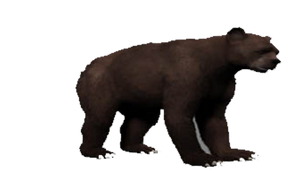(Adding categories) Tag: categoryselect |
(Adding categories) Tag: categoryselect |
||
| Line 38: | Line 38: | ||
[[Category:Kong Skull Island]] |
[[Category:Kong Skull Island]] |
||
[[Category:Frank Welker]] |
[[Category:Frank Welker]] |
||
| + | [[Category:Heroes]] |
||
Revision as of 21:30, 9 September 2017
|
Carnivores
| |
|
Species
|
Arctodus
|
|
Size
|
12 feet (3.657 meters) tall, 1500-2500 pounds
|
|
Abilities/weaponry
|
Massive forepaws, long sharp claws, jaw strength, sharp teeth, sheer size, strength, speed, senses, intelligent, roar,
|
|
Turf
|
North America
|
|
Timespan
|
Late Pleistocene 10,000 Ka
|
|
Appearances
|
First appearance: "Ice Age Monsters" (only appearance)
|
Arctodus ("bear tooth"), also known as the short-faced bear, is an extinct genus of bear endemic to North America during the Pleistocene ~3.0 Ma.—11,000 years ago, existing for approximately three million years. Arctodus simus may have once been Earth's largest mammalian, terrestrial carnivore. It was the most common of early North American bears, being most abundant in California.
Arctodus appeared in the episode "Ice Age Monsters", the ninth episode of Jurassic Fight Club and the only to take place in the Pleistocene. In the episode, Arctodus fights an American Lion over a carcass. He gets bitten, but throws his enemy into a cave.
Description
Based on the skeletons that have been found, Arctodus stood 12.5 feet tall to the shoulder on hind legs and weighed as much as 2,500 pounds twice as big as the largest bears living today. Besides his enormous size, Arctodus had several features that set him apart from modern bears, including oversized teeth and a short muzzle relative to his wide skull, a fact that earned him/her the nickname short-faced bear or bulldog bear. It also had unusually long front legs, which might have allowed it to reach speeds of more than 45 miles per hour and travel much greater distances than modern-day bears.
Fighting style
One of the giant bear's lethal weapons as a predator was its massive paws, equipped with long sharp claws and powered by a strong upper body. Its teeth also had the strength to crush bone with a force that could reach more than 2,000 pounds per square inch. Arctodus was well-adapted for close combact situations as it could intimidate with its sheer size and use its power to throw down and crush its enemies.
Diet
Most scientists believe Arctodus was an apex predator in its habitat because it could run down and overpower its prey mainly-bison, but perhaps also larger animals such as wooly mammoths. Others have argued that despite having the size necessary to be a mega-predator, Arctodus was too light-boned to be able to bring down such huge prey. Some of them think instead that the giant bear was a scavenger, relying mainly on the kills of other predators for survival.
Trivia
- The giant bear, Arctodus simus can be distinguished from another type of North American short-faced bear, Arctodus pristinus by its superior size. The closest living relative to the short-faced bear that exists today is Tremarctos ornatus, more commonly known as the spectacled bear of South America.
